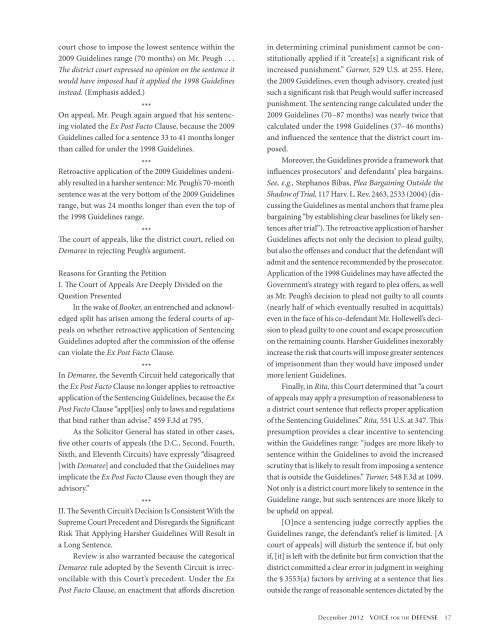tcdla - Voice For The Defense Online
tcdla - Voice For The Defense Online
tcdla - Voice For The Defense Online
You also want an ePaper? Increase the reach of your titles
YUMPU automatically turns print PDFs into web optimized ePapers that Google loves.
court chose to impose the lowest sentence within the<br />
2009 Guidelines range (70 months) on Mr. Peugh . . .<br />
<strong>The</strong> district court expressed no opinion on the sentence it<br />
would have imposed had it applied the 1998 Guidelines<br />
instead. (Emphasis added.)<br />
***<br />
On appeal, Mr. Peugh again argued that his sentencing<br />
violated the Ex Post Facto Clause, because the 2009<br />
Guidelines called for a sentence 33 to 41 months longer<br />
than called for under the 1998 Guidelines.<br />
***<br />
Retroactive application of the 2009 Guidelines undeniably<br />
resulted in a harsher sentence: Mr. Peugh’s 70-month<br />
sentence was at the very bottom of the 2009 Guidelines<br />
range, but was 24 months longer than even the top of<br />
the 1998 Guidelines range.<br />
***<br />
<strong>The</strong> court of appeals, like the district court, relied on<br />
Demaree in rejecting Peugh’s argument.<br />
Reasons for Granting the Petition<br />
I. <strong>The</strong> Court of Appeals Are Deeply Divided on the<br />
Question Presented<br />
In the wake of Booker, an entrenched and acknowledged<br />
split has arisen among the federal courts of appeals<br />
on whether retroactive application of Sentencing<br />
Guidelines adopted after the commission of the offense<br />
can violate the Ex Post Facto Clause.<br />
***<br />
In Demaree, the Seventh Circuit held categorically that<br />
the Ex Post Facto Clause no longer applies to retroactive<br />
application of the Sentencing Guidelines, because the Ex<br />
Post Facto Clause “appl[ies] only to laws and regulations<br />
that bind rather than advise.” 459 F.3d at 795.<br />
As the Solicitor General has stated in other cases,<br />
five other courts of appeals (the D.C., Second, Fourth,<br />
Sixth, and Eleventh Circuits) have expressly “disagreed<br />
[with Demaree] and concluded that the Guidelines may<br />
implicate the Ex Post Facto Clause even though they are<br />
advisory.”<br />
***<br />
II. <strong>The</strong> Seventh Circuit’s Decision Is Consistent With the<br />
Supreme Court Precedent and Disregards the Significant<br />
Risk That Applying Harsher Guidelines Will Result in<br />
a Long Sentence.<br />
Review is also warranted because the categorical<br />
Demaree rule adopted by the Seventh Circuit is irreconcilable<br />
with this Court’s precedent. Under the Ex<br />
Post Facto Clause, an enactment that affords discretion<br />
in determining criminal punishment cannot be constitutionally<br />
applied if it “create[s] a significant risk of<br />
in creased punishment.” Garner, 529 U.S. at 255. Here,<br />
the 2009 Guidelines, even though advisory, created just<br />
such a significant risk that Peugh would suffer increased<br />
punishment. <strong>The</strong> sentencing range calculated under the<br />
2009 Guidelines (70–87 months) was nearly twice that<br />
calculated under the 1998 Guidelines (37–46 months)<br />
and influenced the sentence that the district court imposed.<br />
Moreover, the Guidelines provide a framework that<br />
influences prosecutors’ and defendants’ plea bargains.<br />
See, e.g., Stephanos Bibas, Plea Bargaining Outside the<br />
Shadow of Trial, 117 Harv. L. Rev. 2463, 2533 (2004) (discussing<br />
the Guidelines as mental anchors that frame plea<br />
bargaining “by establishing clear baselines for likely sentences<br />
after trial”). <strong>The</strong> retroactive application of harsher<br />
Guidelines affects not only the decision to plead guilty,<br />
but also the offenses and conduct that the defendant will<br />
admit and the sentence recommended by the prosecutor.<br />
Application of the 1998 Guidelines may have affected the<br />
Government’s strategy with regard to plea offers, as well<br />
as Mr. Peugh’s decision to plead not guilty to all counts<br />
(nearly half of which eventually resulted in acquittals)<br />
even in the face of his co-defendant Mr. Hollewell’s decision<br />
to plead guilty to one count and escape prosecution<br />
on the remaining counts. Harsher Guidelines inexorably<br />
increase the risk that courts will impose greater sentences<br />
of imprisonment than they would have imposed under<br />
more lenient Guidelines.<br />
Finally, in Rita, this Court determined that “a court<br />
of appeals may apply a presumption of reasonableness to<br />
a district court sentence that reflects proper application<br />
of the Sentencing Guidelines.” Rita, 551 U.S. at 347. This<br />
presumption provides a clear incentive to sentencing<br />
within the Guidelines range: “judges are more likely to<br />
sentence within the Guidelines to avoid the increased<br />
scrutiny that is likely to result from imposing a sentence<br />
that is outside the Guidelines.” Turner, 548 F.3d at 1099.<br />
Not only is a district court more likely to sentence in the<br />
Guideline range, but such sentences are more likely to<br />
be upheld on appeal.<br />
[O]nce a sentencing judge correctly applies the<br />
Guide lines range, the defendant’s relief is limited. [A<br />
court of appeals] will disturb the sentence if, but only<br />
if, [it] is left with the definite but firm conviction that the<br />
district committed a clear error in judgment in weighing<br />
the § 3553(a) factors by arriving at a sentence that lies<br />
out side the range of reasonable sentences dictated by the

















